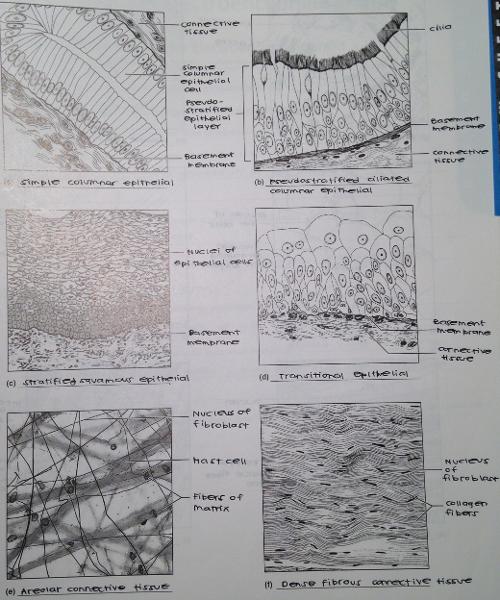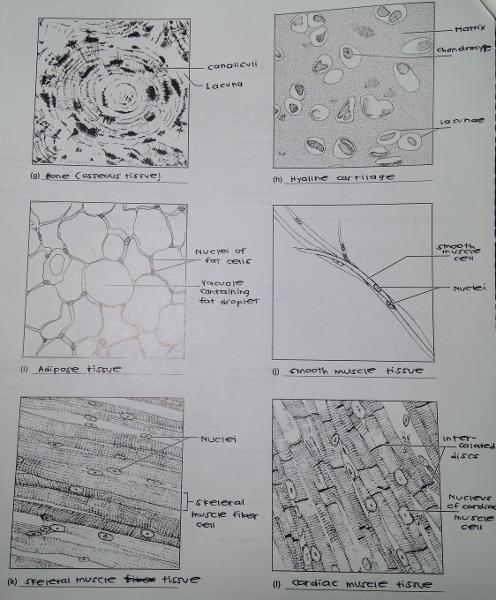Tissue
Group of cells that are similar in structure
Connective tissue
- anchors, packages, and supports body organs
- the most durable tissue type
- abundant nonliving extracellular matrix
- most widespread tissue in the body
Epithelium tissue
- lines body cavities and covers the body's external surface
- cells may absorb, secrete and filter
- synthesizes hormones
Muscle tissue
- pumps blood, flushes urine out of body, and allows one to swing a bat
- major function is to contract
Nervous tissue
- transmits electrical signals
- most involved in regulating and controlling body functions
- forms nerves and the brain
Describe five general characteristics of epithelial tissue.
Polarity, Cellularity (specializd contacts-cells fit closely together) , Supported by Connective tissue, Avascularity and Regeneration
On what basis are epithelial tissues classified?
arrangement or relative number of layers and cell shape
List five major functions of epithelium in the body, and give examples of each.
1. protection; epithelium covering body surface protects against
bacterial invasion and chemical damage.
2. absorption; epithelium specialized to absorb substances lines
the stomach and small intestines.
3. filtration; in kidney tubules, epithelium filters (and
absorbs and secretes)
4. excretion; Sweat is excreted from the body by epithelial
cells in the sweat glands
5. secretion; In glands, epithelial tissue is specialized to
secrete specific chemical substances such as enzymes, hormones and
lubricating fluids
How does the function of stratified epithelia differ from the function of simple epithelia?
Stratified epithelia has more layers for protection, simple epithelia allow materials to move across them and are less protective.
Where is ciliated epithelium found? What role does it play?
Lining of the trachea, most of the upper respiratory tract. There role is to secrete substances, mucus; propulsion of mucus by ciliary action.
Transitional epithelium is actually stratified squamous epithelium with special characteristics. How does it differ structurally from other stratified squamous epithelia? How does the structural difference support its function?
- When stretched, its top layers are squamous, when not stretched, top layers are pillow shaped.
- The surface cells have the ability to slide over one another, increasing the internal volume of the organ.
How do the endocrine and exocrine glands differ in structure and function?
Endocrine glands are ductless, and there function is to release all hormones into the extracellular fluid where they enter blood stream and lymphatic vessels. But Exocrine glands have ducts, and they secrete through the ducts to an epithelial surface.
Simple Squamous
- Alveolar sacs of lungs
- Forms the thin serous membranes; a single layer of flattened cells
Simple Cuboidal
- Tubules of the kidney
Simple Columnar
- Lining of the stomach
Stratified Squamous
- Lining of the esophagus
- Epidermis of the skin
Transitional
- Lining of bladder; peculiar cells that have the ability to slide over each other
What are three general characteristics of connective tissues?
1. Rich supply of blood vessels.
2. Composed of many types of cells.
3. There is a great deal of noncellular, nonliving material
(matrix) between the cells of connective tissues.
What functions are performed by connective tissue?
protection, support, and bind together tissues of the body
How are the functions of connective tissue reflected in its structure?
There is a wide variety in the structures of connective tissue. This is reflected in the wide variety of functions they perform. Also, the large amount of nonliving matrix seen provides the strength needed to protect the body and carry out the normal functions of the body.
Adipose connective tissue
- acts as a storage depot for fat
- insulates against heat loss
Areolar connective tissue
- composes basement membranes; a soft packaging tissue with a jellylike matrix
Dense fibrous connective tissue
- attaches bones to bones and muscles to bones
- the dermis of the skin
Elastic cartilage
- provides a flexible framework for the external ear
- walls of large arteries
Fibrocartilage
- makes up the intervertebral discs
Hyaline cartilage
- forms the larynx the costal cartilages of the ribs and the embryonic skeleton
- firm structurally amorphous matrix heavily invaded with fibers; appears glassy and smooth
Osseous tissue
- forms the hip bone
- matrix hard owing to calcium salts; provides levers for muscles to act on
Why do adipose cells remind people of a ring with a single jewel?
They contain a large fat-filled vacuole occupying most of the cell volume. The nucleus is pushed to the periphery, giving the cell a "signet ring" appearance.
What two physiological characteristics are highly developed in neurons, nerve cells?
iirritability and conductivity
In what ways are neurons similar to other cells?
they contain a nucleus and the usual organelles
How are neurons and other cells different?
their cytoplasm is drawn out into long processes
Describe how the unique structure of a neuron relates to its function in the body.
Neurons conduct impulses over relatively long distances in the body, this is facilitated by their long cytoplasmic extensions
Skeletal
- voluntarily controlled
- striated
- has several nuclei per cell
- found attached to bone
- allows you to direct your eyeballs
- contains branching cylindrical cells
- contains long, nonbranching cylindrical cells
- concerned with locomotion of the body as a whole
Cardiac
- involuntarily controlled
- striated
- has a single nucleus in each cell
- has intercalated discs
- changes the internal volume of an organ as it contacts
- tissue of the heart
Smooth
- involuntarily controlled
- has a single nucleus in each cell
- found in the walls of the stomach, uterus and arteries
- contains spindle-shaped cells

